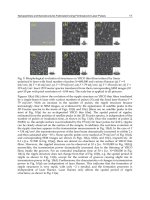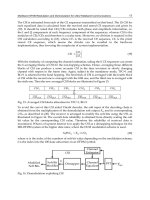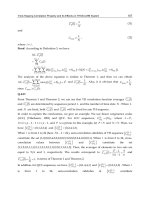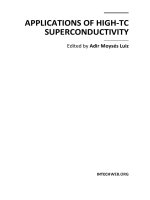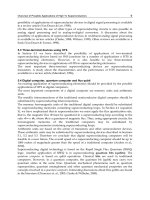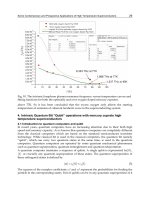Applications of High Tc Superconductivity Part 2 pot
Bạn đang xem bản rút gọn của tài liệu. Xem và tải ngay bản đầy đủ của tài liệu tại đây (5.05 MB, 20 trang )
Overview of Possible Applications of High Tc Superconductors
9
possibility of applications of superconductor devices in digital signal processing is available
in a review article (Van Duzer & Lee, 1990).
On the other hand, the use of other types of superconducting circuits is also possible in
analog signal processing and in analog-to-digital converters. A discussion about the
possibility of applications of superconductor devices in wideband analog signal processing
is available in review articles (Clarke, 1988; Withers, 1990). Other reviews are available in a
book (Van Duzer & Turner, 1998).
5.3 Three-terminal devices using HTS
In Section 5.1 we have described the possibility of applications of two-terminal
superconducting devices based on SNS junctions for a number of applications o HTS in
superconducting electronics. However, it is also feasible to use three-terminal
superconducting devices in applications of HTS in superconducting electronics.
The most important three-terminal superconducting devices are superconducting
transistors. A study about the characteristics and the performance of HTS transistors is
available in a review article (Mannhart, 1996).
5.4 Digital computer, quantum computer and flux qubit
An exciting application of superconducting electronics should be provided by the possible
applications of HTS in digital computers.
The most important components of a digital computer are memory units and arithmetic
units.
The metallic interconnections of the traditional semiconductor digital computer should be
substituted by superconducting interconnections.
The memory ferromagnetic units of the traditional digital computer should be substituted
by superconducting memories containing superconducting loops. In Section 4.1 (equation
5), we have emphasized that in superconductors we must apply the flux quantization rule,
that is, the magnetic flux
Φ
must be quantized in a superconducting loop according to the
rule:
Φ
= n
Φ
0
, where
Φ
0
is a quantum of magnetic flux. Thus, using appropriate circuits, the
ferromagnetic memories of the traditional computers may be substituted by
superconducting memories containing superconducting loops.
Arithmetic units are based on the action of transistors and other semiconductor devices.
These arithmetic units may be substituted by superconducting devices described in Sections
5.1, 5.2 and 5.3. Therefore we conclude that digital superconducting computers will be
feasible in a near future. The overall speed of a superconducting computer should be up to
1000 orders of magnitude greater than the speed of a traditional computer (Anders et al.,
2010).
Superconducting digital technology is based on the Rapid Single Flux Quantum (RSFQ)
logic. Another application of RSFQ is in superconducting quantum bits (qubits). The
quantum computer is based on qubit operations. Classical bits are used in traditional
computers. However, in a quantum computer, the quantum bit (qubit) may carry two
quantum states at the same time. Quantum mechanical phenomena such as quantum
superposition, quantum entanglement and other quantum mechanical properties are the
concepts involved in a quantum computer. Interesting discussions about flux qubits are found
in the literature (Chiorescu et. al., 2003; Clarke & Wilhelm, 2008).
Applications of High-Tc Superconductivity
10
6. Possible applications of HTS in medicine
The ultimate objective of science and technology is human welfare. Thus, it is natural to ask
how superconductivity may be applied in medicine. Medical applications of HTS involve
small scale as well as large scale applications of superconductivity.
The most important large scale applications of superconductivity are Magnetic Resonance
Spectroscopy (MRS) and Magnetic Resonance Imaging (MRI).
The most important small scale applications of superconductivity are those applications
based on the properties of SQUIDs and Josephson junctions (Sections 4 and 5). We have
pointed out that SQUIDs are the most sensitive devices for magnetic field measurements. It
is well known that blood contains ions. Therefore, the circulation of blood produces small
magnetic fields that can be detected using SQUIDs.
By measurement of the magnetic fields produced by blood circulation in the human body it
is possible to make non-invasive diagnosis of diseases. The most important applications of
HTS in medicine are (1) magnetoencephalography (MEG) for non-invasive tests of the brain
activity and (2) magnetocardiography (MCG) for non-invasive tests of the heart activity. The
magnetic activity of other regions of the human body may also be detected using SQUIDs.
A study about the state-of-the-art and future developments of applications of
superconductivity in medicine is available in a review article (Anders et al., 2010).
7. Concluding remarks
In this chapter we have studied the most relevant questions about the possible applications
of HTS. The history of superconductivity has not been smooth. Generally, very slow process
was witnessed between breakthroughs. Practical applications of superconductivity follows a
breakthrough with a time lag of about 30 years.
Practical applications of HTS are emerging steadily every year. However, as we have
stressed in the Introduction, radical technological solutions should depend on the discovery
of a HTS material with critical temperature in the neighborhood of room temperature.
However, what happens to the basic science of HTS? As it has been noted in a recent book
(Luiz, 2010), the microscopic mechanisms in HTS are unclear. However, nearly every year
new theories are proposed and new HTS materials are synthesized.
Large scale applications of HTS have a bright future. Electric energy production and energy
storage are the most important large scale applications of HTS. On the other hand, small
scale applications of HTS have a bright future as well; these applications are more feasible
than large scale applications of HTS. Because small scale applications of HTS generally
involve small volumes, that is, very small Josephson junctions volumes, it is not necessary to
use cryostats with liquid helium (or liquid nitrogen). In some very small systems, it is
sufficient to use a thermodynamic cycle to maintain the temperature of the system at a value
lower than the critical temperature of the material. On the other hand, experimental
evidences show that HTS behave like a stack of superconductor-insulator-superconductor
interfaces (SIS junctions) and superconductor-normal-superconductor interfaces (SNS
junctions), that is, HTS materials may be considered as a network of intrinsic Josephson
junctions (Kleiner & Müller, 1994; Machida & Tachiki M, 2001).
Finally, according to the study in Section 5, we claim that applications of HTS materials and
SNS junctions should give new radical solutions for the use of superconducting devices in
superconducting electronics.
Overview of Possible Applications of High Tc Superconductors
11
The future of applications of HTS is very exciting. Because HTS materials are brittle, it is
necessary to overcome this difficulty. Nevertheless, this drawback exists only in the
fabrication of cables and coils (see Section 2). However, in a great number of HTS
applications it is sufficient to use HTS cylindrical blocks. We hope that the researches
described in this overview will be helpful for the discovery of new practical applications of
HTS.
8. References
Alvarez, G.; Taylor, K. N. R. & Russell, J. G. (1990). Josephson behavior of variable thickness
bridges in textured YBa
2
Cu
3
O
7
. Physica C, 165, pp. 258-264
Anders, S.; Blamire, M.G.; Buchholz, F lm; Crété, D G.; Cristiano, R.; Febvre, P.; Fritzsch, L.;
Herr, A.; Il’ichev, E.; Kohlmann, J.; Kunert, J.; Meyer, H G.; Niemeyer, J.; Ortelepp,
T.; Rogalla, H.; Schurig, T.; Siegel, M.; Stolz, Tarte, E.; Brake, H.J.M.ter; Toepfer, H.;
Villegier, J C.; Zagoskin, A.M. & Zorin, A.B. (2010). European roadmap on
superconductive electronics - status and perspectives. Physica C, 470, 23-24, pp.
2079-2126
Barone, A. & Paternò, G. (1982). Physics and Applications of the Josephson Effect. John Wiley,
New York
Bednorz, J. G. & Müller, K. A. (1986). Possible high T
c
superconductivity in the Ba-La-Cu-O
system. Zeitschrift fur Physik B, Condensed Matter, 64, 2, pp. 189-193
Cava, R. J. (2000). Oxide superconductors. Journal American Ceramic Society, 83, 1, pp. 5-28
Chiorescu, I.; Nakamura, Y.; Harmans, C. J. P. M. & Mooij, J. E. (2003). Coherent quantum
dynamics of a superconducting flux qubit. Science, vol. 299, n. 5614, pp. 1869-1871
Clarke, J. (1988). Small-scale analog applications of high-transition-temperature
superconductors. Nature, vol. 333, n. 5, pp. 29-35
Clarke, J. & Wilhelm, F. K. (2008). Superconducting quantum bits. Nature, vol. 453, n. 7198,
pp. 1031-1042
Davis, L. C.; Logothetis, E. M. & Soltis, R. E. (1988). Stability of magnets levitated above
superconductors. J. Appl. Phys., Vol. 64, No. 8, pp. 4212–4218
David, E. G.; Stephan, R. M.; Andrade Jr, R. & Nicolsky, R. (2006). Feasibility study of an
HTS-MAGLEV line at the Federal University of Rio de Janeiro. In Proc. of MAGLEV
2006, Dresden, Germany, pp. 749-752
Davydov, A. S. (1990). Theoretical investigation of high-temperature superconductivity.
Physics Reports (Review Section of Physics Letters), 190, 4-5, pp. 191-306.
Fair, R.; Lewis, C.; Eugene, J. & Ingles, M. (2009). Development of an hydroelectric power
generator for the Hirschaid Power Station, Germany. In EUCAS - 2009, September
13-17, Dresden, Germany, p. 124
Golovashkin, A. I.; Gudkov, A. L.; Krasnosvobodtsev, S. I.; Kusmin, L. S.; Likharev, K. K.;
Maslennikov, Yu. V.; Pashkin, Yu. A.; Petchen, E. V & Snigirev, O. V. (1989).
Josephson effect and macroscopic quantum interference in high-Tc
superconducting thin film weak links at T= 77 K. Report presented at 1988 Applied
Superconductivity Conference. IEEE Trans. Magn., 25, pp. 943-946
Gorelov, Y. A.; Luiz, A. M. & Nicolsky, R. (1997) Heterodyne Mixer Using a superconductor
- normal metal - superconductor junction. Physica C, vol. 287, pp. 2491 - 2492
Applications of High-Tc Superconductivity
12
Güven Ö., Z.; Aslan, Ö. & Onbaşlı, Ü. (2009). Terahertz oscillations in mercury cuprate
superconductors. Pramana-Journal of Physics, vol. 73, n. 4, pp. 755-763
Hull, J. R. (2000). Superconducting bearings. Supercond. Sci. Technol., vol. 13, pp. R1–R15
Josephson, B. D. (1962). Possible new effects in superconductive tunneling. Phys. Lett., 1, pp.
251-253
Kleiner, R. & Müller, P. (1994). Intrinsic Josephson effects in high-T
c
superconductors, Phys.
Rev. B, vol. 49, n. 2, pp. 1327-1341, ISSN: 1098-0121
Koch, R. H.; Umbach, C. P.; Clark, G. J.; Chaudhary, P. & Laibowitz, R. B. (1987). Quantum
interference devices made from superconducting oxide thin films. Appl. Phys. Lett.,
51, pp. 200-202
Kummel, R.; Gunsenheimer, U. & Nicolsky, R. (1990). Andreev scattering of quasiparticle
wave packets and current – voltage characteristics of superconducting metallic
weak links. Physical Review, B42, pp. 3992-4009
Likharev, K. K. (1986). Dynamics of Josephson Junctions and Circuits. Gordon and Breach, New
York
Luiz, A. M. (1993). Superconducting negative resistance switches. Japanese J. of Applied
Physics, vol. 32, n. 11A, pp. 4971-4972
Luiz, A. M. (2010). A model to study microscopic mechanisms in high-Tc superconductors,
Superconductor, Adir Moysés Luiz (Ed.), ISBN: 978-953-307-107-7, Sciyo, Available
from the site: />microscopic-mechanisms-in-high-tc-superconductors
Luiz, A. M.; Soares, V. & Nicolsky, R. (1999). Superconductor - Normal Metal -
Superconductor junctions for signal amplification and harmonic multiplication.
IEEE Transactions on Magnetics, vol. 35. pp. 4100-4102
Luiz, A. M.; Gorelov, Y. A. & Nicolsky, R. (1999). Simulation of conversion gain and
reflectivity coefficients in heterodyne detector using a superconductor - normal
metal - superconductor junction. IEEE Transactions on Applied Superconductivity, vol.
9. pp. 44-48
Luiz, A. M.; Soares, V. & Nicolsky, R. (1998). Simulations of signal amplification and
oscillations using a SNS junction. Journal de Physique IV France, vol. 8, pp. 271 - 274
Luiz, A. M.; Pereira, L. A. A. & Nicolsky, R. (1997). Heterodyne detector using a SNS
junction. IEEE Transactions on Applied Superconductivity, vol. 7, n. 2, pp. 3719 – 3721
Luiz, A. M. & Nicolsky, R. (1993). Negative Resistance Switch Using a SNS Junction. IEEE
Transactions on Applied Superconductivity, vol. 3, pp. 2714-2715
Luiz, A. M. & Nicolsky, R. (1991). Microbridges and point contacts as negative differential
resistance devices in the conventional generation of microwaves, up to the sub-
millimeter range. Physica C, vol. C189, pp. 2589-2591
Luiz, A. M. & Nicolsky, R. (1991). Radiofrequency generation using a SNS microbridge.
IEEE Transactions on Magnetics, vol. 27, n. 2, pp. 2712 - 2715
Luiz, A. M. & Nicolsky, R. (1991). Microwave generation using a SNS junction. Japanese
Journal of Applied Physics, 30, pp. 1218-1219
Luiz, A. M. & Nicolsky, R. (1990). SNS microbridge as a superconducting harmonic
generator. Progress in High Temperature Superconductivity, vol. 25. Editor: Roberto
Nicolsky, World Scientific, Singapore, pp. 733-736
Overview of Possible Applications of High Tc Superconductors
13
Ma, K. B.; Postrekhin, Y. V. & Chu, W. K. (2003). Superconductor and magnet levitation
devices. Rev. Sci. Instrum., vol. 74, n. 12, pp. 4989–5017
Machida M. & Tachiki M. (2001). Terahertz electromagnetic wave emission by using
intrinsic Josephson junctions of high-Tc superconductors. Current Appl. Phys., vol.
1, n. 4-5, 341-348, ISSN: 1567-1739. Editors: Orlando, T. P. & Delin, K. A. (1991).
Foundations of Applied Superconductivity, Addison-Wesley Pub. Co., New York.
Mankiewich, P. M.; Schwartz, D. H.; Howard, R. E.; Jackel, L. D.; Straughn, B. L.; Burkhardt,
E. G. & Dayem, A. H. (1988). Fabrication and characterization of a YBa
2
Cu
3
O
7
/Au/
YBa
2
Cu
3
O
7
S-N-S microbridge. Fifth International Workshop on Future Electron
Devices – High Temperature Superconducting Devices, June 2 – 4, pp. 157-160,
Japan
Mannhart, J. (1996). High-Tc transistors. Supercond. Science Technol., 9, pp. 49-67
Minami, H.; Kakeya, I. ; Yamaguchi, H.; Yamamoto, T. & Kadowaki, K. (2009).
Characteristics of terahertz radiation emitted from the intrinsic Josephson
junctions in high-Tc superconductor Bi
2
Sr
2
CaCu
2
O
8+
δ
. Appl. Phys. Lett., vol. 95, n.
23, pp. 1- 3
Nicolsky, R. & Luiz, A. M. (1992). Superconducting metallic Josephson junctions as negative
resistance devices in the conventional generation of microwaves. Proceedings of the
Asiatic-Pacific Microwave Conference, Adelaide, Australia, pp. 15-18
Noe, M. & Steurer, M. (2007). High-temperature superconductor fault current limiters:
concepts, applications, and development status. Supercond. Science Technol., 20, pp.
R15-R29
Polasek, A.; Serra, E. T. & Rizzo, F. C. (2009). On the melt processing of Bi-2223 high-Tc
superconductor - challenges and perspectives. In Superconducting Magnets and
Superconductivity. Editors: Tovar, H. & Fortier, J. Chapter 5, pp. 1-16, Nova Science
Publishers, Inc., New York
Ruggiero, S. T. & Rudman, D. A. (Editors) (1990). Superconducting Devices, Academic Press,
Inc., New York
Schilling, A. & Cantoni, M. (1993). Superconductivity above 130 K in the Hg-Ba-Ca-Cu-O
system. Nature, 363, 6424, pp. 56-58
Stephan, R. M.; David, E. G. & de Hass, O. (2008). MAGLEV COBRA: An Urban
transportation solution using HTS superconductors and permanent magnets. In
Proc. of MAGLEV 2008, San Diego, California, pp. 1-4
Sotelo, G. G.; Dias, D. H. N.; Andrade Jr, R. & Stephan, R. M. (2010). Tests on a
superconductor linear magnetic bearing of a full-scale maglev vehicle. IEEE Trans.
Appl. Supercond., doi: 10.1109/TASC.2010.2086034, pp. 1-5
Van Duzer, T. & Lee, G. (1990). Digital signal processing. In Superconducting Devices, Editors:
Ruggiero, S. T. & Rudman, D. A., Academic Press, Inc., New York
Van Duzer, T. & Turner, G. (1998). Principles of Superconductive Devices and Circuits. Prentice
Hall, New Jersey
Withers, R. S. (1990). Wideband analog signal processing. In Superconducting Devices,
Editors: Ruggiero, S. T. & Rudman, D. A., Academic Press, Inc., New York
Wolsky, A. M. (2002). The status and prospects for flywheels and SMES that incorporate
HTS. Physica C 372–376, pp. 1495–1499
Applications of High-Tc Superconductivity
14
Zimmerman, J. E.; Beall, J. A.; Cromar, M. W. & Ono, R. H. (1987). Operation of a Y-Ba-Cu-O
RF SQUID at 81 K. Appl. Phys. Lett., 51, pp. 617-618
2
Some Contemporary and Prospective
Applications of High Temperature
Superconductors
Z. Güven Özdemir
1
, Ö. Aslan Çataltepe
2
and Ü. Onbaşlı
3
1
Yıldız Technical University, Physics Department,
Davutpaşa Cad. Esenler, İstanbul, 34210
2
Anatürkler Educational Consultancy & Trading Company,
Cemil Topuzlu Cad. Üçem Konak No:73 D:1 Göztepe,Kadıköy
3
Marmara University, Physics Department,
Rıdvan Paşa Cad. 3. Sok. 4/12 Göztepe, Istanbul,
Turkey
1. Introduction
High temperature superconductors (HTS) have a wide range of very sensitive and reliable
advanced technological applications. In this chapter, some examples of contemporary and
prospective usage of the superconductors such as in vivo living body measurements in
medicine, terahertz equipments for security systems, quantum bit namely “qubit” applications
in quantum computation and bolometers for some space investigations will be dealt with.
Especially in medicine, superconductors have been reliably utilized in Magnetic Resonance
Imaging (MRI), Magnetic Resonance Spectroscopy (MRS), magnetoencephalography (MEG)
and magnetocardiography (MCG) for both analysis of magnetic activity of different regions
of the human body such as brain and heart’s wave activities and very early diagnosis of
several diseases. All equipments mentioned above contain Superconducting Quantum
Interference Device (SQUID), which is based on the Josephson Effect. SQUID is a very
sensitive magnetic detector to determine the change of the magnetic flux in material media
of the order of 10
-15
T
, which coincides with the order of magnetic flux quanta, Φ
=
2.067810
. The sensitivity of SQUID is revealed easily by remembering the fact that
the magnetic field of the Earth equals to 5x10
-5
Tesla.
Besides these contemporary applications in medicine mentioned above, the Proton-MRS (P-
MRS) measurements will be proposed for forensic science investigations as one of the
prospective implementations of HTS’s. Because of the fact that some in vivo investigations
via P-MRS provide the facility to detect the minor changes of metabolites in human brain
(Onbaşlı et al., 1999), the method, which enables to detect the mild head injuries, which
cannot be recognized according to Glasgow Coma Scale (GCS) (Teasdale & Jennett, 1974)
from the neurological point of view, will be presented in this chapter.
Moreover, one of the remarkable features of HTS is that some oxide layered HTS work as a
terahertz wave source. From this point of view, HTS‘s are also utilized in security systems,
in remote sensing and non-destructive diagnosis. As was previously determined that the
Applications of High-Tc Superconductivity
16
mercury based copper oxide layered HTS (mercury cuprates) act as a natural terahertz wave
cavity at particular temperature interval (Özdemir et al., 2006; Güven Özdemir et al., 2009).
Hence, some part of the chapter will be related to the investigation of the terahertz emission
of the superconductor mentioned.
The last part of the chapter will be related to the facility of prospective application of the
mercury cuprates as a quantum bit, “qubit” in particular flux qubit (Güven Özdemir,
2011), which is based on the occurrence of the two fluxoid states with equal energy but
opposite circulating current at the same time in the system (Mooij et al., 1999). As is
known, qubits are fundamentally considered as the main building block of both quantum
computation, quantum communication etc. In recent years, quantum computers, which
are based on qubit operations, have an increasing attention due to their both high speed
and memory capacity. In the present superconducting qubit technology, some low
temperature superconductors especially aluminum thin film superconductors have been
extensively utilized. In this context, for a prospective usage of HTS, mercury cuprates as
one of the oxide layered high temperature superconductors will be proposed as an
intrinsic flux qubit in this chapter.
2. Clinical usage of Superconducting Quantum Interference Device (SQUID)
The superconducting magnets in ultra sensitive magnetic detectors (1.5 Tesla and above)
namely SQUID magnetometer (Superconducting Quantum Interference Device) implement
the reliable observation of the metabolites in the living organisms for the clinical
applications.
Fig. 1. Magnitudes of some biomagnetic fields (Fishbine, 2003).
Some Contemporary and Prospective Applications of High Temperature Superconductors
17
As is known, the functions of human body are realized by the displacement of ions such as
Na
+
, K
+
, Cl
-
etc.
The displacement of the ions corresponds to a current which produces a
magnetic field. In Figure 1, the magnitudes of biomagnetic fields together with the other
magnetic field sources are given.
According to Figure 1, especially biomagnetic fields produced by neuron cells’ activities are
very weak. They have magnetic field strengths of fT (femtoTesla i.e. 10
-15
T). For comparison,
the Earth’s magnetic field is measured in micro Tesla and a magnetic resonance imaging
system operates at several Tesla. The detection of such very small magnetic fields reliably is
realized by the most sensitive magnetic field detector known as Superconducting Quantum
Interference Device, namely SQUID.
A SQUID uses the properties of electron-pair wave coherence and Josephson Effect to
detect very small magnetic fields. For example, to measure the magnetic field, that is
produced by the electrical activity in brain, a special non-invasive imaging technique
namely Magnetoencephalography (MEG), which contains SQUID sensors, are used
(Fishbine, 2003).
In Figure 2, the representative illustration of detection of physical activities in human brain
by MEG is given. The accuracy of measuring brain waves by MEG depends on the magnetic
shielding of SQUID sensors from ambient magnetic fields such as the magnetic field of the
Earth, power line’s magnetic field and etc.
Fig. 2. Representative illustration of detection of physical activities in human brain by MEG
(Fishbine, 2003).
Applications of High-Tc Superconductivity
18
As it is seen from Figure 2, SQUID sensors and the superconducting lead shell are cooled by
immersion in liquid helium. In the superconducting state, lead shell expels ambient
magnetic fields at all frequencies and hence it is ensured that SQUID sensor is only detect
the magnetic field generated by brain waves. Each SQUID sensor contains a coil of
superconducting wire that receives the brain fields and is magnetically coupled to the
SQUID, which produces a voltage proportional to the magnetic field received by the coil. A
computer program converts the SQUID data into maps of the currents flowing throughout
the brain as a function of time (Fishbine, 2003).
2.1 Proton Magnetic Resonance Imaging (P-MRI) for medical diagnosis
Approximately 80% of human body is composed of water molecules and each water
molecule consists of two hydrogen nuclei i.e. protons. In P-MRI measurements, the nuclear
spins of hydrogen nuclei are aligned in one direction by applying strong magnetic fields of
1.5-3T that are generated by superconducting magnets. Afterwards, the polarized spins in
one direction are excited by properly tuned radio frequency radiation. When the influence
of short pulse of radio waves is removed, they drift back to their initial position, thereby
Fig. 3. (a) The working principle of P-MRI (Bayer, 2010). (b) The schema of superconducting
magnets (National High Magnetic Field Laboratory, FSU, 2010).
Some Contemporary and Prospective Applications of High Temperature Superconductors
19
emitting electromagnetic signals that can be used to reconstruct an image of the inside of the
body. The protons in different tissues of the body (e.g. fat, muscle and etc.) realign at
different speeds, so that the different structures of the body can be revealed (Georgia State
University, 2010; Wikipedia, 2010; Bayer, 2010). The main steps of P-MRI are given in Figure
3(a).
The MRI technique has been extensively used for especially imaging the brain, heart,
muscles and joints, for early diagnosis of cancer cells.
Superconducting magnets have a crucial role in P-MRI measurements. A superconducting
magnet is an electromagnet made from coils of superconducting wire. Superconducting
magnets can produce stronger and homogeneous magnetic fields than iron-core magnets.
The most remarkable feature of the superconducting magnets is their capability of
supporting very high current density with a vanishingly small resistance.
In conventional MRI devices, low temperature type II superconductors such as NbTi alloy
are used to make coil windings for superconducting magnets. The illustration of typical
superconducting magnet is shown in Figure 3(b).
Although, superconducting magnets are relatively more expensive to be build than ordinary
iron-core magnets and require a constant supply of liquid helium closed cycle system,
superconducting magnets have great advantages to detect very weak signals come from
different sections of brain. If an ordinary magnet is used in MRS, only a giant water peak is
observed, since approximately 80% of the tissue investigated consists of water molecule.
Usage of superconducting magnet, which generates strong magnetic fields of 1,5-3T, enables
both to suppress the signal comes from water molecules and distinguish the very weak
signals, which have slightly different frequencies and that come from different metabolites
secreted at the vicinity of the related tissue (Salibi & Brown, 1998).
2.2 Proton Magnetic Resonance Spectroscopy (P-MRS)
P-MRS generally produces spectra via Fourier transformation process of the tissue
investigated instead of creating an image of the tissue. In vivo P-MRS, an appropriate radio
frequency is applied the tissue and the signal comes from the tissue is measured and the
Fig. 4. P-MRS results of healthy human brain by means of metabolites. (Blamire, 2010)
Applications of High-Tc Superconductivity
20
Fourier transformation technique is used. In vivo P-MRS use position, signal intensity and
line width along with spectral patterns to display chemical information about the related
metabolites. A “ppm i.e. parts per million” scale describes the position of the peaks or
resonances on the x-axis. Each peak in the spectrum arises from different brain metabolites.
The heights of the peaks in the vertical axis refer to the concentrations of metabolites in
arbitrary intensity scale.
In Figure 4, the proton magnetic resonance spectroscopic curve of a healthy human brain
tissue with N-acetylaspartate (NAA), creatine (Cr), cholin (Cho) and etc. metabolite peaks is
shown. Some of the metabolite peaks appear at the specific ppm value in the x-axis of the
spectroscopic data. For example NAA peak appears at 2.0 ppm and NAA is accepted as the
neural marker. While the primary resonance of Cr lies at 3.03 ppm, Cho resonates at 3.2 ppm
(Danielsen &Ross, 1999; Blamire, 2010; Frahm et al., 1989).
2.3 In vivo experimental detection of Mild Traumatic Brain Injury (MTBI) by means of
Proton Magnetic Resonance Imaging (P-MRI) and Proton Magnetic Resonance
Spectroscopy (P-MRS)
In this chapter, we will focus on the detection of mild traumatic brain injuries (MTBI) by
means of both Proton Magnetic Resonance Imaging (P-MRI) and Proton Magnetic
Resonance Spectroscopy (P-MRS) techniques based on our experimental investigations.
Although, the physical principle of both neuro-imaging techniques are the same, the
information comes from these methods are completely different. Whereas the magnetic
interaction between applied magnetic field and hydrogen nuclei is considered for P-MRI,
the detection of chemical variation at the vicinity of hydrogen nuclei is realized in P-MRS.
The main goal of this section is to determine mild traumatic brain injury (MTBI) at which no
significant pathology is seen by imaging studies and that is considered as healthy based
upon the Glasgow Coma Score (GCS).
As is known, a neurological GCS, which was published in 1974 (Teasdale & Jennett, 1974),
aims to give a reliable information about the status of the central nervous system in three
types of tests: eye, verbal and motor responses of the patient. The GCS is given in Table 1.
In GCS, the sum of the value that is related to the three types of tests (eye, verbal and motor)
is used to assess the level of consciousness after head injury. According to the values in
Table 1, while “the lowest possible score of 3” corresponds to the deep coma or death, “the
highest score of 15” indicates the fully awake person.
Generally brain injuries are classified as severe with GCS ≤ 8, moderate with CGS:9-12 and
minor GCS ≥ 13.
In MTBI, often no lesion or a few numbers of lesions are detected by MRI findings so that in
many cases neuoro-imaging findings do not completely explain the clinical symptoms. In
this context, P-MRS is commonly used for in vivo detection of variation of the quantity of
metabolites in brain (Ariza et al., 2004; Govindaraju et al., 2004). P-MRS is a very sensitive
and noninvasive in vivo technique to assess the metabolic status of brain which can quantify
selected cerebral metabolites including N-acetylaspartate (NAA), a marker of neuronal and
axonal viability (Bachelard & Badar-Goffer, 1993), total creatine (Cr), which reflects energy
status, total choline (Cho) a marker of membrane metabolism, lactate (Lac), which is an
indicator of ischemia and mobile lipids.
Although, the MRI findings indicate a normal central nervous status in post MTBI, it has
been determined by P-MRS that concentrations of the cerebral metabolites mentioned above
Some Contemporary and Prospective Applications of High Temperature Superconductors
21
Score Infant (<1 year old) Child (1-4 years old) Adult
RESPONSES of EYES
4 Open Open Open
3 To voice To voice To voice
2 To pain To pain To pain
1 No response No response No response
VERBAL RESPONSES
5 Coos, babbles Oriented, speaks, interacts, social Oriented and alert
4 Irritable cry, consolable
Confused speech, disoriented,
consolable
Disoriented
3 Cries persistently to pain In appropriate words, inconsolable Nonsensical speech
2 Moans to pain Incomprehensible, agitated
Moans,
unintelligible
1 No response No response No response
MOTOR RESPONSES
6
Normal, spontaneous
movement
Normal, spontaneous movement Follow commands
5 Withdraws to touch Localizes pain Localizes pain
4 Withdraws to pain Withdraws to pain Withdraws to pain
3 Decorticate flexion Decorticate flexion Decorticate flexion
2 Decerebrate extension Decerebrate extension
Decerebrate
extension
1 No response No response No response
Table 1. Glasgow Coma Score (Teasdale & Jennett, 1974).
change. Several studies with P-MRS have indicated that it is possible to detect neural injury
i.e. loss of neuron by comparing these concentrations and the related ratios of pre and post
MTBI (Luyten &Den Hollander, 1986; Cecil et al., 1998; Friedman et al., 1998; Friedman et
al., 1999; Onbaşlı et al., 1999; Garnett et al., 2000; Brooks et al., 2000; Holshouser, 2000;
Garnett et al., 2001; Rao et al., 2006). Whereas death of neurons manifests itself as the
deficiency of NAA concentration, the increased Cho concentration is related to the cell
membrane breakdown (Brooks et al., 2001). These changes both occur in occipital, parietal
and frontal lobes and the splenium of the corpus callosum of brain regions (Ross et al.,
1998). The related regions of brain are seen in Figure 5.
In MTBI, the metabolic abnormality is relatively small and due to this reason no lesion in
brain tissue is observed in P-MRI results and the related GCS is higher than 14. Moreover, as
is known from medical literature, these patients generally exhibit prolonged neurological
deficits. In this context, P-MRS is considered as the most sensitive probe for detection of
minor changes in brain metabolites. Determination of MTBI has a significant role for both
Applications of High-Tc Superconductivity
22
Fig. 5. The brief anatomy of human brain (Royal Adelaide Hospital web site, 2010; Weber
State University web page, 2010).
medical diagnosis about the neuron loss percentage and that for forensic science
investigations.
In this context, the MTBI has been investigated via four volunteers experimental subjects
1
(mean age: 25 years old; age range: 23-27 years old; mean weight: 75 kg; sex: male;
profession: sportsman) by detection of NAA, Cho and Cr metabolites with P-MRS for pre
and post trauma for both corpus callosum splenium and frontal white lobe of brain.
To obtain MTBI, sportsmen performed boxing for five minutes as a practice by using
boxing gloves and head guard for protection. All experimental subjects were fully awake
according to GCS of “15” for pre and post MTBI. No lesion such as hematoma or
ecchymose was viewed in P-MRI experiments in pre and post MTBI. For comparison, MRI
photographs of sagittal section for pre and post MTBI of one of the experimental subjects
are given in Figure 6 (Eruygun, 1998). The results have been confirmed by professional
neurologist that no difference between the images given in Figure 6, which were taken
from corpus callosum splenium and frontal white lobe of brain, has been detected before
and after minor trauma.
After taking the MRI for post trauma, P-MRS experiments were realized within one and half
hour after trauma. Proton single voxel spectroscopy
2
experiments have been performed for
corpus callosum splenium and frontal white lobe of brain. The data obtained by pre and
post P-MRS experiments are listed in Table 2 for the sections of brain mentioned above.
1
All volunteers have been informed about the investigation process and they all accepted the
experiment.
2
The single voxel techniques generate a cubic or rectangular shaped volume element i.e. voxel with
maximum 8cm
3
volume for a region of the sample with P-MRS. Two pulse sequences are used in P-
MRS: The STEAM (STimulated Echo Acquisition Mode) and PRESS (Point RESolved Spectroscopy).
Both STEAM and PRESS sequences generate cubic or rectangular shaped voxel by acquisition of three
orthogonal slice selective 90
o
pulses and 90
o
pulse followed by two 180
o
pulses, respectively. In the
STEAM technique, the signal contamination outside the tissue observed is minimum.
Some Contemporary and Prospective Applications of High Temperature Superconductors
23
(a) Pre-trauma for sagittal section
(b) Post trauma for sagittal section
Fig. 6. MRI images of experimental subject 1 for (a) pre trauma and (b) post trauma from
sagittal section. MR imaging of these regions were performed by General Electric Signa 1.5T
MRI device.
As is seen from Table 2, the neuron marker, NAA, decreases after the minor brain trauma,
whereas the replenishing metabolites of Cholin, increases for every lesions of the all
volunteers’ brain.
The pre and post trauma P-MRS photographs of one of the experimental subject for the both
corpus callosum splenium and the white frontal lobe of brain are given in Figure 7 and 8,
respectively. The heights of peaks of the metabolites for pre and post trauma are marked on
the left and the right of the photographs, respectively.
Applications of High-Tc Superconductivity
24
As is seen from Figure 7 and 8 no pathologic peak has been observed.
Fig. 7. Brain P-MRS images one of the experimental subject for corpus callosum splenium.
Fig. 8. Brain P-MRS images one of the experimental subject for white frontal lobe.
Some Contemporary and Prospective Applications of High Temperature Superconductors
25
Brain Sections
Corpus Callosum
Splenium
Pre trauma
Corpus Callosum
Splenium
Post trauma
White Frontal
Lobe Pre trauma
White Frontal
Lobe Post
trauma
Metabolites NAA Cr Cho NAA Cr Cho NAA Cr Cho NAA Cr Cho
Experimental
Subject 1
126 46 57 118 34 63 123 42 53 120 47 60
Experimental
Subject 2
120 52 47 120 49 73 123 54 52 120 53 84
Experimental
Subject 3
128 43 63 122 38 70 129 60 66 123 44 81
Experimental
Subject 4
118 42 57 114 40 75 123 46 55 116 61 77
Table 2. By means of chemical shift of metabolites in MRS results for pre and post MTBI
(Eruygun, 1998; Onbaşlı et al, 1999).
2.4 Conclusion
The observation of the change in the amplitude of brain metabolites at the vicinity of
hydrogen nuclei via P-MRS has been only used for clinical diagnosis for several years. In
addition to clinical researches, a new method for determining of closed and mild brain
injuries, which are caused due to psychological pressure, beating or any kind of abusing,
has been introduced for forensic science investigation for the first time. Moreover, in order
to make clear beyond a reasonable doubt for the detection of such mild brain trauma, the P-
MRS has been suggested as the most reliable scientific tool for forensic science investigations
as well as medical diagnosis.
3. High temperature superconductors as a new terahertz wave sources
Terahertz waves have various advanced technological applications including medical
diagnosis, security, biomedical imaging, atmospheric researches, drug and food inspection,
gas tracing etc. (Tonouchi, 2007). Terahertz waves also known as T-waves, exist a frequency
region between microwaves and far infrared of the electromagnetic spectrum. As is seen
from Figure 9, terahertz waves occupy a region from 300 GHz to 10 THz that can provide
imaging and sensing technologies not available through conventional technologies such as
X-rays.
In recent years, T-waves are extensively utilized for non-destructive security devices since
many materials and living tissues are semi-transparent at terahertz wavelengths and also
have distinct THz absorption spectra namely “finger prints”. Unlike X-rays, THz radiation
posses a little or no health threat since that T-ray photons are both not strong enough to
ionize atom or molecules and not able to break the chains of chemical bonds
3
. Moreover, T-
waves, especially in 1-10 THz region, have great advantages for biomedical imaging such as
tumor recognition, detection of dental cavities etc. due to its non-invasiveness and low
Rayleigh scattering property factor compared with optical waves (Lu et. al., 2010).
Furthermore, DNA molecules and many proteins have collective vibration and rotation
3
THz waves have low photon energies (1 THz = 4.1 meV), one million times weaker than X-rays, and
do not cause harmful photoionization in biological tissues.
Applications of High-Tc Superconductivity
26
Fig. 9. Terahertz waves in the electromagnetic spectrum (Zomega Terahertz Corp, 2010).
The terahertz gap lies between electronics and photonics.
modes that coincide with THz region. Due to this reason, T-waves have also a crucial
importance for molecular imaging (Zuhang et.al, 1990; Young et al., 1990; Feng et.al, 1991;
Nossal & Lecar, 1991).
There are many ongoing researches for developing terahertz wave sources. One of the most
popularly used terahertz wave sources is optoelectronic terahertz wave generators. In this
process, near-infrared laser light illuminates a metal-semiconductor-metal structure that
results in a photocurrent which is utilized as terahertz wave. Ultrafast fiber lasers and diode
lasers & photo-mixers are used for “pulsed” and “continuous wave” sources, respectively.
In recent years, the semi-conducting light sources have extended the limit of emission of T-
rays to 1.6 THz for quantum cascade lasers and 1.5 THz for unitravelling-carrier photo
diodes (Ito et. al. 2005; Walther et. al, 2006). On the other hand, the frequency of alternating
currents in semiconductors is limited by finite electron velocities, while that of solid state
lasers are limited by thermal energies which prevent the small electronic transition required
for lasing at THz wavelengths.
Among the sources mentioned above, superconductors, especially the high temperature
superconductors that display “Intrinsic Josephson Effect” (IJE), may be the excellent
promising candidate for terahertz source due to their extremely low noise factor and wide
frequency coverage (Emuidzinas & Richards, 2004; Güven Özdemir et al, 2009, Moody,
2009). Very recently, continuous and monochromatic terahertz wave emitter with the
frequency of 0.63THz has been achieved for the intrinsic Josephson junctions in high
temperature Bi
2
Sr
2
CaCu
2
O
8+
δ
superconductor by applying d.c. voltage in the order of
milivolt (Minami et. al. 2009). The voltage due to the fluxon flow mechanism in the system
excites the Josephson plasma with terahertz frequency. The frequency of 0.63THz can be
considered as the beginning of the filling the THz gap, that is defined between 300 GHz to
10 THz, by high temperature superconducting terahertz sources. The long term goal of the
scientists working on that area is to cover the whole THz gap by superconducting coherent
terahertz wave sources.
In this chapter, the copper oxide layered mercury based cuprate family superconductors,
HgBa
2
Ca
2
Cu
3
O
8+x
, which have the highest Meissner transition temperature of 140K ever
obtained at normal atmospheric pressure and display IJE, is proposed as an intrinsic
terahertz wave source, since there is no need to apply any bias voltage to the system.
Some Contemporary and Prospective Applications of High Temperature Superconductors
27
3.1 Mercury cuprates as an intrinsic terahertz wave sources
As is known that the copper oxide layered high temperature superconductors such as
Bi
2
Sr
2
CaCu
2
O
8
, Tl
2
Ba
2
Ca
2
Cu
3
O
10
, HgBa
2
Ca
2
Cu
3
O
8+x
etc. have a common structure in which
superconducting copper oxide layers are separated by a thin insulating layer. Copper oxide
layers are electromagnetically coupled together by Josephson tunneling process. According
to the experimental evidences, cuprates such as Bi
2
Sr
2
CaCu
2
O
8
, Tl
2
Ba
2
Ca
2
Cu
3
O
10
and
YBa
2
Cu
3
O
7-x
behave like a stack of superconductor-insulator-superconductor structure i.e.
intrinsic Josephson junctions (IJJ) (Kleiner & Müller, 1994; Özdemir et. al, 2006; Güven
Özdemir et. al., 2009)
As is known, the main Josephson plasma excitation modes in weakly Josephson coupled
layered superconductors are longitudinal (along the c-axis) and transversal (in the ab-
plane) plasma modes. Whereas the transverse-mode plasma oscillations can be converted
into electromagnetic waves at the boundary of the junctions (Machida & Tachiki, 2001),
the longitudinal plasma propagation modes in an array of IJJ do not lead the
electromagnetic wave radiation, since the electromagnetic wave has only transverse mode
(Bae &Lee, 2006).
Mercury based superconductors have been considered as an array of IJJ. Since, the Interlayer
Theory
4
is valid at low temperatures for the optimally oxygen doped mercury cuprates
(Özdemir et. al, 2006), all copper oxide layers along the c-axis of the system are in the
resonance with the Josephson plasma frequency that coincides to the THz gap (Güven
Özdemir et. al, 2007). This type of Josephson plasma resonance mode cannot be attributed to
the fluxon flowing mechanism, since the working magnetic field interval never exceeds the
lower critical magnetic field of the system. Hence, the magnetic flux is totally expelled from
the superconductor. The phenomenon is displayed as a perfect diamagnetic response on
SQUID data. Ultimately, the terahertz plasma oscillations determined in the system provide
the bulk mercury cuprate superconductor as an intrinsic coherent terahertz wave source
without application of any external voltage.
The Josephson plasma frequency values for the mercury cuprates had already been
calculated via magnetic critical current density J
c
, which was deduced by magnetization
versus magnetic field curves obtained by SQUID
5
(Özdemir et. al, 2006; Güven Özdemir
et. al., 2009). The Josephson plasma frequency, f
P
is calculated via Josephson penetration
depth,
J
λ
.
2
P
J
c
f
πλ
=
(1)
where
J
λ
describes the penetration depth of the magnetic field induced by the supercurrent
flow in the superconductor. The Josephson penetration depth is defined as
4
According to Interlayer theory, electron pairing in the superconducting state makes the transport
process along the c-axis to be coherent via Josephson (Lawrence-Doniach like) coupling between the
superconducting copper oxide layers. Moreover, in order to provide the coherent transport mechanism
along the c-axis, the Josephson coupling energy must be equal to the superconducting condensation
energy (Anderson, 1997; Anderson 1998).
5
The critical current density at the vicinity of lower critical magnetic field had already been calculated
by Bean critical state model.
Applications of High-Tc Superconductivity
28
0
2
8
J
c
c
Jd
φ
λ
π
= (2)
where, c is the speed of light,
c
J is the magnetic critical current density,
0
φ
is the magnetic
flux quantum, and d is the average distance between the copper oxide layers (Ferrel &
Prange, 1963; Ketterson & Song, 1999; Fossheim & Sudbo, 2004).
We have calculated the intrinsic Josephson plasma frequencies for the optimally and over
oxygen doped Hg-1223 superconductors. The related data have been listed in Table 3.
The optimally oxygen doped Hg-1223
superconductors
The over oxygen doped Hg-1223
superconductors
Temperature (K) Plasma Frequency, f
p
(Hz) Temperature (K) Plasma Frequency, f
p
(Hz)
4.2 8.303x10
13
5 3.295x10
13
27 3.363x10
13
17 2.175x10
13
77 8.303x10
12
25 1.981x10
13
77 1.866x10
12
90 1.537x10
12
Table 3. The Josephson plasma frequencies for the optimally and over oxygen doped Hg-
1223 cuprate superconductors (Özdemir et al., 2006; Güven Özdemir et al., 2007; Güven
Özdemir, 2007).
In Figure 10, the Josephson plasma frequency versus temperature curves and the related
fitting functions for both the optimally and over oxygen doped HgBa
2
Ca
2
Cu
3
O
8+x
superconductors are shown.
The temperature dependence functions of the Josephson plasma frequency for the optimally
and over oxygen doped Hg-1223 superconductors have been determined by Origin Lab 8.0
graphic program. According to the fitting functions given in Eqs. (3) and (4), an extra doping
of oxygen atoms to the optimally doped system changes the temperature dependence of f
P
and also lowers the plasma frequencies.
()
()
13 12
12
3
8.303 10 8.303 10
8.303 10
1
21.65914
for the optimally oxygen doped Hg-1223 superconductor
P
fT
T
×− ×
=×+
+
(3)
()
()
() ()
12 13 12
11 0.05941 15 0.05882
0.5 1 0.5
1.537 10 3.29503 10 1.537 10
110 110
for the over oxygen doped Hg-1223 superconductor
P
TT
fT
−− −−
−
=×+ ×−× +
++
(4)
3.2 Brief conclusions for mercury cuprate intrinsic terahertz wave sources
Both the optimally and over oxygen doped mercury cuprate samples exhibit intrinsic
terahertz Josephson plasma frequencies at relatively high temperatures. The optimally
oxygen doped system starts to emit a coherent terahertz waves at the vicinity of liquid
nitrogen temperature of 77K, whereas for the over oxygen doped samples, this effect starts
